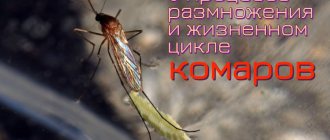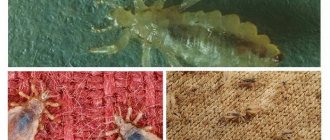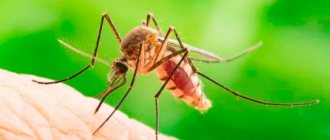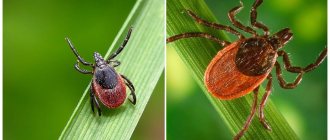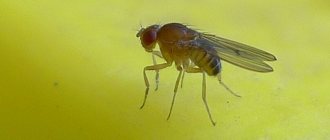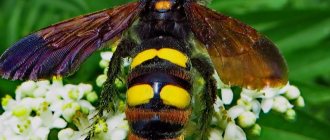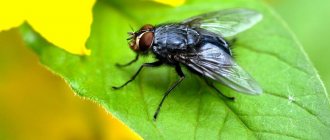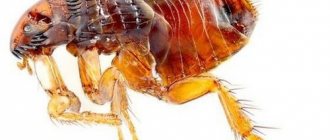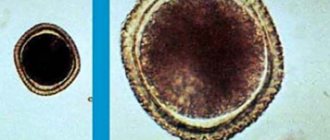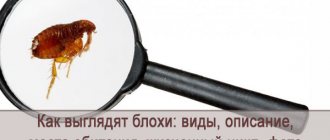The complex structure of a mosquito. What is such a simple insect at first glance? Why do females need human blood? Life cycle and stages of development of a mosquito. Reproduction and characteristics of females. Benefits from mosquitoes and important for nature.
When it comes to mosquitoes, this does not evoke the most pleasant emotions for us; we imagine unbearably annoying insects that emit very irritable squeaks and inflict bites, as a result of which we suffer from itching. We also know that they are quite dangerous because they can carry diseases.
There are many types of mosquitoes and there are some that are absolutely safe for people. It’s hard to believe, but these insects have not been fully studied by scientists, and we don’t know everything about them. Next, we will look at them in more detail, find out the structure of a mosquito, their life cycle, and the characteristics of these insects.
Anatomy
If scientists have not yet fully studied this small insect and quite a lot of questions remain, then all the details regarding their structure are known. At first glance, such a “primitive” creature without any special features is very complex. Their small body has almost all the internal organs of higher mammals.
Regardless of the type of mosquito, they all have similar external signs. They have a small thin body, the length depending on the species reaches 4-14 mm. All individuals have thin, long legs and transparent wings. The narrow wings can have a span from 5 mm to 3 cm, which also depends on the specific species. The color of the body is gray, brown or yellow; there are species that have rare colors, black and green.
The structure of a mosquito is divided into head, chest and abdomen. Individuals have six legs, the abdomen is always smaller in size than the chest. The chest is divided into 10 segments. When blood-sucking animals are saturated, the abdomen swells and increases significantly in size, so in saturated individuals the abdomen is larger than the chest.
Meaning in human life
If we consider mosquitoes on a global level, they benefit all living things. They contribute to plant pollination, are carriers of beneficial microelements, and also serve as food for a large number of animals and fish. If mosquitoes disappear completely, it could negatively impact all wildlife. If we talk about people, then here they cause more harm: they cause itchy bites, and also increase the likelihood of contracting one of the dangerous diseases.
Why does a mosquito bite itch?
Itching in humans after a mosquito bite occurs due to the saliva secreted by the female. It contains a protein that causes an allergic reaction, and with it redness of the skin, swelling and itching.
Allergy to mosquito bite
There are cases when, after the first bite, a person does not feel such symptoms, because the body has not yet managed to recognize this protein. Scientists have also found that with a large number of bites, the body simply gets used to the substance, and the person stops noticing them. If a person has an increased level of sensitivity, a serious allergic reaction may develop.
Head structure
These individuals have perfect infrared vision. There are compound eyes on the head that provide full all-round visibility. This allows them to avoid danger and for the same reason, it is not so easy for us to kill this insect.
Also on the head there are antennae, which include 15 segments. The very first segment is located on the head, and the second has Johnston's organ, which is an organ of hearing. The first distinguishing feature between males and females is the antennae.
After the first 2 come the whip segments; in females they are cylindrical in shape and covered with short hairs, which are quite few. But in males they have a conical shape, which is covered with thick and long hairs.
Even without using a microscope, this is easy to notice because the antennae appear fluffy. According to scientists, these bloodsucking antennae partially replace the olfactory organ, since it is absent.
They have a piercing-sucking type of mouthparts. It includes 6 sharp needles that are covered with a flexible, soft cover. The cover performs the protective function of the proboscis and protects it from damage. The first four needles are placed in the form of a stiletto; the first outer ones have an additional file, which provides easy puncture of the skin. The role of their teeth is performed by hard chitinous bristles.
They have hollow internal tubes, it is designed for saturation, through which the mosquito sucks blood. The mosquito uses the second tube to inject poison, which serves as an anesthetic.
Only females have a fairly complex structure of the oral apparatus. In males it is underdeveloped and their diet consists exclusively of flower nectar.
Despite the rather small size of their heads, mosquitoes have a large brain. It has 2 longitudinal nerve trunks that run parallel to each other in the chest area and connect above the pharynx in the head.
Also, the main part of the brain is supplemented by ganglia; they are nerve nodes that are located in the abdomen and are also located in the chest segments. The ganglia perform a very important function, since they coordinate the work of absolutely all organs.
Habitats
Almost all mosquitoes prefer warm, humid environments, including the tropics. However, we will never meet them in the Arctic and Antarctica.
The most dangerous individuals for humans live in India, Thailand, China and South America. To visit these countries, tourists are recommended to be vaccinated.
A lot of mosquitoes can be found in Thailand. Mostly malarial, tiger and centipede mosquitoes live there. Before visiting the country, it is recommended to get vaccinated.
The so-called “Crimean” mosquito lives in Crimea, settles in basements, and is capable of carrying dangerous infections.
The most popular mosquito in the world is the common mosquito. It can be found wherever people live, because... human plasma is its main source of nutrients necessary for reproduction.
Breast
If we talk about the general appearance, then this part looks quite massive, but after studying it in more detail, you can understand that this is not entirely true. It includes 3 segments that are unevenly developed.
The strongest and most developed middle part, it contains all the flying muscles, and the wings are also attached. In addition to being responsible for flight, the middle part provides respiratory functions.
The front part includes the insect's fairly long neck. The rear part, the metanotum, has another spiracle and is also responsible for the insect’s respiration, but unlike the middle segment, it is rather poorly developed.
Each segment has a pair of legs. The paws, in turn, also consist of segments, of which there are 5 on each limb. On the last segment there are suction cups and claws, which allow the mosquito to stay on absolutely any surface and ideally stay on the ceiling.
It’s interesting, but now mosquitoes have a slightly different body structure; previously they had 4 wings, but now there are only 2 left. However, now they still have rudiments of the halteres from the second pair of wings, which produce this incredibly annoying squeak. By the way, only females squeak, as well as bite.
The wings have an oval elongated shape and a transparent color. They consist of veins and connecting membranes; the plates are covered with very small scales. Most individuals have transparent scales, but there are also those with different color shades. If colored scales accumulate in one place, a colored spot is formed.
In species of mosquitoes that have black and green colored bodies, colored scales accumulate in such a way that a pattern is formed. It’s hard to believe that these small insects wave with a vibration frequency of up to 1000 times per second. Some scientists argue that the wings also contain nerve endings, but in this case they act as sensory organs.
Description
The common mosquito (in Latin Culex pipiens) is a type of blood-sucking mosquito distributed throughout the globe. Insects are carriers of various diseases of humans (for example, meningitis, Japanese encephalitis, helminthic infestations) and animals (for example, avian malaria).
Mosquitoes are small insects whose size rarely exceeds 7 mm. Female mosquitoes are larger than males, but even their weight rarely reaches 1 g, unless you weigh an individual that has just sucked enough blood.
Appearance
Another name for the insect is the squeak mosquito. The mosquito squeak that irritates people is the sound made by the wings of an insect, which it flaps 500 - 700 times per second. But at the same time, the mosquito’s flight speed is low, the maximum value is about 3.2 km/h. Insects rarely move long distances, preferring to live and hunt in a very limited area.
Attention! The role of mosquitoes in nature is difficult to overestimate. Each generation takes many chemical elements from reservoirs, which subsequently enter the soil with the body of the dead insect, nourishing it. In addition, mosquitoes are an integral part of a large number of food chains.
Digestive tract
No matter how strange it may sound, the digestive tract of mosquitoes begins with the head. The oral apparatus connects to the foregut, which in turn is divided into the pharynx, which has extensions before and after the brain.
The foregut has three esophageal appendages and two salivary glands. But they do not perform any digestive functions; they are storage tanks for food and water reserves, so the insect can do without a food source for a long time.
When there is no source of food for a long time, the reserves enter the stomach, where the process of processing and assimilation of food occurs. There is also a small and rectal hindgut.
Varieties of blood-sucking insects
In total, there are more than three thousand species of insects on Earth. Up to a hundred of their species have taken root on the territory of Russia. The most common are:
- the common mosquito is a ubiquitous species that tends to annoy both animals and people; the insect's body size reaches 8 mm and is a carrier of meningitis and eczema;
Centipede mosquito - dolopoda - lives near water bodies, in swampy places, is a threat to agricultural plantings, because this insect feeds only on plants;
- Anopheles is a mosquito that is dangerous to humans because it infects people with malaria through its bites; it lives near bodies of water and is practically no different in appearance from the ordinary species;
- two-striped - inhabitant of forests and swamps, carrier of dangerous diseases;
- winter mosquitoes - found near water bodies, body length reaches two centimeters, living conditions differ from other species, survive in winter by living in rotten wood.
Circulatory system
The entire circulatory system is supported by the work of the heart and diaphragm. In other words, blood is pumped, but there is no separate system. If you were wondering whether a mosquito has a heart, then the answer is clear - no.
There are no hearts in our usual understanding; they are presented in the form of a muscular tube, like a trachea, which acts as a heart and ensures blood circulation in the body. This tube is located between 1-7 abdominal segments. Interestingly, insects themselves have colorless blood.
How does a mosquito bite?
Having discovered the victim, the female mosquito lands on the skin, hooking its claws, then bites, that is, pierces the skin with sharp stilettos. Then the insect injects saliva into the wound, which has an analgesic effect and slows down blood clotting. After this, the bloodsucker plunges its proboscis into the nearest blood vessel and begins to suck blood from it.
Mosquito bite
Examining the process of a mosquito bite under a microscope, you can see that the strong proboscis is at the same time very flexible. In search of a suitable capillary and at the moment of penetration into it, the proboscis can bend freely and turn in different directions. Most often, the bite lasts 1-2 minutes, but sometimes, in order to get enough, the female sucks blood for 3-4 or even 5 minutes.
Differences between females and males
In addition to external differences, females and males have different food preferences. Females feed on blood because it is a source of essential microelements for procreation. When the female is saturated with blood, she looks for a secluded place for herself, where for several days she can digest the food she receives and at the same time wait for the offspring to mature.
For males, it is enough to get carbohydrates, which are contained in the nectar of flowers. They are processed in the body into glycogen, which the insect needs to obtain energy. There are differences in the structure of the oral apparatus; females have special needles with which they puncture the skin, while males simply do not have them.
A fairly striking difference between females and males is the antennae. In the female half they are quite inconspicuous, resembling 2 inconspicuous antennas, but in the male representatives they are much more beautiful, reminiscent of fluffy and soft feathers.
Lifestyle
Do you know where mosquitoes live? The habitat of these bloodsuckers will depend on the following factors:
- type of insect - some are able to exist in a temperate climate, for others the most suitable place to live is tropical forests;
- location of the food source - at a certain period of life, females feed on the blood of humans and animals, and therefore they will always be in close proximity to the source of saturation;
- climatic conditions - mosquitoes do not like the cold too much and will always choose a warmer place;
On a note! The optimal air temperature for their normal existence is +16°C!
- high humidity - the most favorable place for reproduction is a place where the air humidity is in the range of 80-90%.
On a note! Scientists note the fact that mosquitoes can adapt to the most unexpected living conditions, and therefore it is possible that they will soon be able to populate Antarctica!
Lifespan
The lifespan of a mosquito is somewhat longer compared to, say, the lifespan of ants and butterflies. However, it is impossible to name the exact period of time, since it depends on:
- gender - nature has allocated only three weeks of life for a male, but for females a much longer period has been prepared, which is about three months;
On a note! The presence of favorable conditions and winter suspended animation extend the lifespan of females - in this case it increases to one year!
- nutrition - how long a mosquito lives is also influenced by its menu, for example, if a source of saturation is constantly nearby, then the female will have the energy to lay eggs and remain in good health after that, but if the diet is insufficient, the young it will turn out weak, and the mosquito itself will die immediately after laying its eggs;
- temperature conditions - despite the fact that these insects take root well in almost any conditions, they still affect their life expectancy; if the ambient temperature is +23°C and above, then the female mosquito will live no more than 43 days, 20...23°C - 58 days, 15...20°C - up to 114 days, 10...15°C - about 120 days .
On a note! The idea that a mosquito dies immediately after being bitten is wrong. In addition, their life expectancy is not affected by the number of people bitten or the amount of blood they drink! After being bitten, the bloodsucker can only die if the victim slams it down!
Life cycle
- An insect goes through four stages of development during its entire life cycle. In the first three stages, namely eggs, larvae and pupae, they develop in a very moist environment, this can be waterlogged soil or water.
- Clutches of eggs can be located in completely different places, where humidity is maintained, larvae emerge from the eggs, and their appearance may differ depending on the species. The external differences of the larvae lie in the shape of the head; in some they are narrow and elongated, while in others, on the contrary, they are wide and short.
- At this stage, they are already quite developed, have organs of vision that are located on the sides of the head and oral apparatus. Depending on the type of mosquito, the mouthparts can be of the sucking or scraping type.
- Species that belong to predatory individuals have mouthparts that can not only catch food, but also chew it. The abdomen itself has 9 segments, and the chest consists of plates that are fused together.
- Regarding the digestive tract of these individuals, it is presented in the form of a straight tube. Food is digested in the intestines, and the digestive tract also has salivary glands and intestinal appendages.
- Next comes pupation, and the larva changes into a pupa. At this stage, individuals are almost completely formed. The pupa has a large number of air chambers, for this reason they are constantly on the surface of the water.
- Unprotected individuals at this stage of development become easy prey and food for fish and other predators. Young sexually mature individuals emerge from the pupae and are ready to reproduce; they go in search of a pair for mating.
Are mosquitoes beneficial?
Much is known about the harm mosquitoes cause, but the benefits of these insects are also considerable. For example, being carriers of dangerous infections, insects regulate the numbers of some animals.
Before you dream of a world without mosquitoes, it’s worth finding out what benefits they bring:
- feeding on the sap and pollen of plants, they participate in pollination;
- Fish, insects, spiders, frogs, birds feed on mosquito larvae and adults (for some animals, mosquitoes are the main food);
- developing in water, the larvae receive many microelements with which the adult insect enriches the soil when it dies;
- during the development process, mosquito larvae filter and purify water in reservoirs, feeding on organic substances, various microorganisms, and rotten plants;
- are an important link in various food chains (one of the most famous is the “mosquito-frog-heron”).
The enemy of mosquitoes
Scientists have found that insects often choose the most painful places on the human body to bite, since more heat emanates from them. The benefit of mosquitoes is that when they bite, they inject saliva, which thins the blood. Thanks to this, blood supply to the affected area improves and even small blood clots in the capillaries disappear.
Reproduction
Not many people know that the female, just like the male, can easily get by with just the nectar of flowers in order to get enough and not die of hunger. But in order for her to continue her race and produce offspring, she needs to be saturated with blood.
The female attracts males to mate with a characteristic squeak. The halteres that they have left after the second pair of wings are capable of emitting a squeak, and not a rough buzz, since they are very small in size. If there is a swarm of mosquitoes nearby and a squeak is heard from there, then the females are ready to reproduce and, of course, they need blood.
These small insects remain a mystery to scientists to this day; many studies have not made it possible to study them to the end and discover all the secrets of their life. But at the same time, we managed to get questions about the main questions, for example, why they squeak, why only females bite, do they have a heart and how many teeth do they have. If you learn a little more about them, they will definitely surprise anyone.
How many times can the same mosquito bite?
Very often, when an annoying insect circles somewhere nearby, every now and then perching on various parts of the body, an irritated person has a question about how many times a mosquito bites.
Unfortunately, the answer is disappointing - there are no restrictions. The female tries to get the amount of blood she needs at one time. But if something bothers her, she will fly away and then return again and again until she is satisfied. In addition, do not forget that it is almost impossible to distinguish one mosquito from another. Therefore, it may seem to a person that he is being chased by one mosquito, although in fact several individuals fly up to him one by one.
Interesting Facts
- There are more than 3,000 species of mosquitoes on Earth.
- These insects originated on our planet approximately 100 million years ago.
- Scientists have found that mosquitoes like to bite sweatier people. They choose their own prey based on exhaled carbon dioxide and body odor.
- As interesting facts about mosquitoes say, if this insect is hungry, it travels up to 64 kilometers in search of food. They can smell food at a distance of up to 50 meters.
- In the Canadian town of Komarno, the world's largest mosquito monument was erected. Its wingspan is 5 meters.
